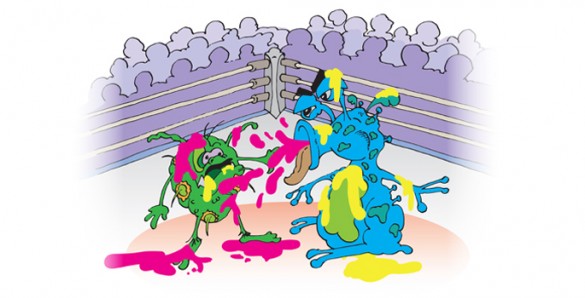Come one, come all to the battle of all battles. We have an antibiotic resistant bacteria versus an antibiotic resistant bacteria. Who has more resistance? Which is more common? Who has a greater risk of infecting people? Who. Will. Win.

In one corner we have the antibiotic resistant organism known as methicillin-resistant Staphylococcus aureus. In the opposite corner we have yet another antibiotic resistant organism, Klebsiella pneumoniae carbapenemase. The two are ready to throw down at any moment. The crowd is screaming vehemently. The intensity in the ring is unbearable. But wait! I have to give you some background information concerning our two fighters first.
According to this article, Klebsiella pneumoniae carbapenemase (KPC)-producing bacteria is an enzyme that degrades penicillin, cephalosporin, and carbapenems. KPC outbreaks have been reported in many countries which is the reason for its’ worldwide attention. It also possesses a higher mortality number than non-KPC producing organisms. KPC just so happens to be a carbapenem-resistant Enterobacteriaceae (CRE) too. The Mayo Clinic says that CRE are strains of bacteria that are resistant to carbapenem. If you’re wondering why this is so bad it’s because carbapenems are a class of antibiotics that are used to treat infections. Those most at risk for developing CRE infections are patients who are required to endure long courses of antibiotic use or who rely on breathing devices. It is important to note that CRE-related infectious outbreaks such as KPC are found in the healthcare setting. That is why it is beneficial to practice appropriate hand washing with soap and water and to never abuse antibiotics.

This now brings us to our second fighter. The harmless looking methicillin-resistant Staphylococcus aureus (MRSA) seen to the left is anything but harmless. In most cases MRSA causes skin infections, but in severe cases it can lead to sepsis. According to the CDC, MRSA is resistant to many antibiotics much like KPC. The scary thing is that almost anyone is at risk of getting MRSA because it is transferred through skin to skin contact. This is why wrestlers are extremely prone to developing MRSA. Since MRSA is resistant to many antibiotics this can lead to the possibility of developing a serious, sometimes fatal infection. Just like KPC, MRSA can be attributed to the overuse of antibiotics.
In a strange turn of events the two fighters have realized that they actually have something in common and are both caused by the overuse of antibiotics. They have decided to join forces and advocate for more overuse and misuse of antibiotics by humans, so they can continue to cause trouble. Sorry ladies and gentlemen, the battle royale has been called off.





